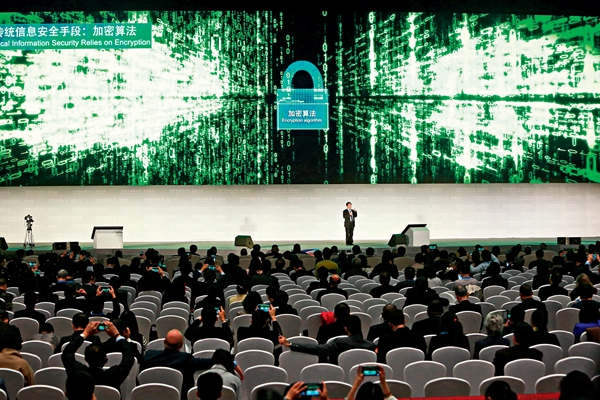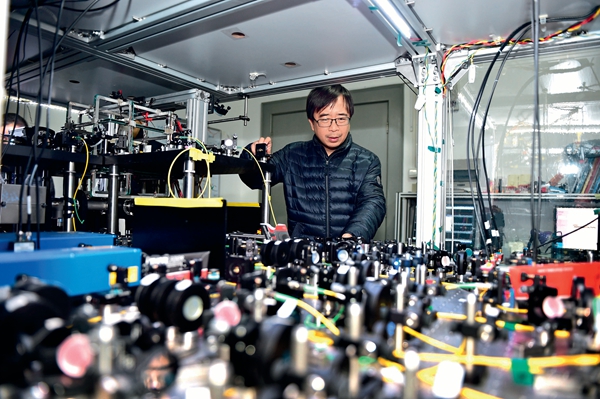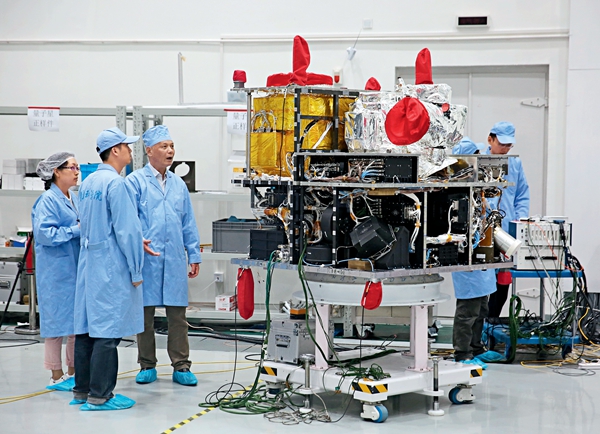Quantum Communication: World Pacemaker
By staff reporter JIAO FENG
THE frontier science of Quantum Information Technology (QIT) consists of quantum communication, quantum computing and quantum precision measurement. In recent years, quantum information has become one of the commanding points in technology and industry. A number of developed countries and regions including the U.S., Japan and the European Union have successfully formulated development strategies for the new technology.

Although China only entered the Quantum Information arena quite recently, it is already competing at an advanced level in many fields of application. Chinese physicists were one of the first to achieve entangled state quantum and teleportation with a secure communication distance of over 100 km. They also created the world’s first large-scale quantum communication network. Chinese scientists have gradually become world leaders in Quantum Information research, particularly in metropolitan applications of QIT and the use of quantum distribution technology for communicating sensitive information – these methods have been transplanted from the laboratory to industry application. In urban areas, a quantum communication network using fiber-optic links has been put into practical application. China’s QIT is a leader in the field.
2016: The First Year of Industrialization
Scientists have found that in the microworld an “entanglement” can be created via a quantum channel whereby the quantum state of an atom can be shared between two locations. No matter how large the distance between the two, if the state of A changes, the state of B will alter correspondingly. Quantum communication is a new mode of sending information that utilizes the quantum entanglement process.
Quantum communication has the benefits of high efficiency and absolute security. Should information be hijacked while being transmitted, both sender and receiver know immediately. Since the hacker cannot obtain all the information, absolute security can be ensured. Therefore, quantum communication is highly applicable in areas of security, such as national defense and protecting financial information.
The year 2016 was a milestone in the industrial development of China’s quantum information. The country drew up initial plans for an industrial chain, from the production of core components, equipment manufacturing, transport network construction, to network operations and applications. It could be said that 2016 was China’s first year of industrialization in quantum communication.
On August 16, 2016, the world’s first quantum experiment satellite, Micius, was successfully launched, making China the first country to achieve quantum communication between a satellite and the earth. The 260-km-long Shanghai-Hangzhou Link – the world’s first commercial quantum communication line – was opened for the use of government offices and local banks, on October 18. The Beijing-Shanghai Link was later connected to transfer important information, and some state-owned commercial banks have already used it to deliver backup. These projects mark the marketization of quantum technology, showcasing China’s quantum application.
Stemming from Curiosity
Since the birth of quantum theory, the academic debate around it has grown enormously, fuelled by the infinite charm of quantum. In recent years, some Chinese scientists have shown long-term commitment to researching the theoretical and practical applications of quantum entanglement, quantum communication, quantum encryption, and quantum computing.

Pan Jianwei, an academician of the Chinese Academy of Sciences and chief scientist on the quantum experiment satellite project, has been fascinated by the problem of quantum superposition states since his college days. In order to understand it, Pan studied quantum mechanics. In 1999, guided by his tutor, Professor Anton Zeilinger, Pan and his colleagues conducted the world’s first quantum photon teleportation experiment. The results were published in Nature magazine, and were regarded as a groundbreaking step in quantum information research. Pan was then 29 years old.
When he returned to China in 2001, Pan was responsible for building a laboratory for research into quantum physics and quantum information, giving China’s zero-based experimental study a head start. In 2004, Pan’s team was the first in the world to achieve five photon entanglement and open-destination teleportation. “In the past, we often played the role of follower and imitator in scientific research,” Pan said. “To designate a research direction and the establishment of a scientific research project, we should first check whether it has been done before. Quantum information is a brand new subject we must learn in order to become the world’s pacemaker and guide.”
Nicknamed the dream team, Pan’s group consists of China’s top physicists and makes significant progress each year. In 2004, using five-photon entanglement, the team realized the first-ever quantum teleportation of open-destination and multiple users. In 2006, utilizing six-photon entanglement, the team was first to achieve quantum teleportation of two-particle composite system. The team also achieved quantum teleportation of multiple degrees of freedom in 2015, and one year later were first to achieve 10-photon entanglement.
In 2008 the team set up the world’s first all-pass quantum communications network. In 2010, the world’s first quantum government affairs network was piloted in Wuhu of Anhui Province. The first large-scale quantum communications network was established in 2012.
Integrated Connection
Thanks to joint efforts of Chinese scientists, the industrialization of quantum communication(QC) has developed rapidly.
The building of large-scale QC metropolitan area networks (MAN) has been accomplished in several cities, including Wuhu, Jinan, Hefei, Hangzhou, and Wuhan. A number of local government offices and finance institutions have applied quantum encryption communication to achieve secrecy in such transmissions as voice calls, faxes, and file transfers. The Beijing-Shanghai Link will join with other MAN to build a macrozone fiber quantum communication network, establishing a platform for large-scale QC technical identification and applied research as well as application demonstration.

Some large commercial banks and telecommunications enterprises not only participate in QC industrial projects, but also enjoy the security it provides. For instance, the Industrial and Commercial Bank of China not only successfully applies QC technology to ensure encrypted transmission of archival information between its branches in Beijing, but also uses it to back up business data in its Shanghai data center and send it to Beijing.
The enormous potential of quantum communication technology is attracting a lot of investors, and became one of the most profitable industries in 2016. As the contractor of Beijing-Shanghai Link, IDQ-QTEC Quantum Technology Co., Ltd. went public in June 2016, becoming the first quantum communication stock on China’s capital market.
The quantum satellite Micius will achieve high-velocity satellite-to-ground quantum key distribution, quantum entanglement and distribution, as well as space-to-ground quantum teleportation. During its in-orbit operation over the next two years, Micius will coordinate with five ground stations to carry out an experimental study of space-ground remote quantum communication. Micius (468-376 BC), a famous philosopher, military strategist and educator in ancient China, demonstrated some highly original views on optics and forces, one of which is said to have been a precursor to Newton’s Law of Inertia. “We want to use his name to remind people that Chinese people can do well in science, in the past, today and in the future,” said Pan.
In the future, dozens of quantum satellites and ground communication lines will form a QC network. Macrozone quantum security communication will later cover the entire country and even go global.
“In the future, perhaps everyone’s cellphone will have a quantum encryption chip. This will allay any worries about hackers when carrying out sensitive transactions like bank transfers and operating electronic accounts,” Pan said.
